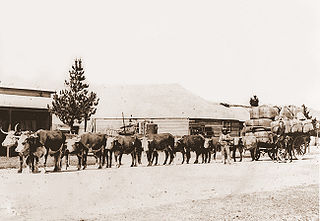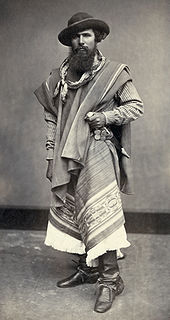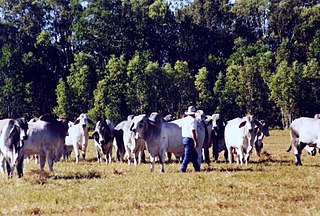 W
WA beekeeper is a person who keeps honey bees.
 W
WA bullocky is an Australian English term for the driver of a bullock team. The American term is bullwhacker. Bullock drivers were also known as teamsters or carriers.
 W
WA buttero or cavalcante is a mounted herder, usually of horses, of cattle, or of buffaloes, in Italy, predominantly in the Maremma region of Tuscany and northern Lazio, or in the Pontine Marshes to the south.
 W
WA campino is a cattle herder in the Portuguese region of Ribatejo.
 W
WA cowman is a person who works specifically with cattle.
 W
WA charro is a traditional horseman from Mexico, originating in the central regions primarily in the states of Jalisco, Nayarit, Colima, Zacatecas, Durango, Chihuahua, Aguascalientes, Querétaro, and Guanajuato The vaquero and ranchero are similar to the charro but different in culture, etiquette, mannerism, clothing, tradition and social status. The inhabitants of southern Salamanca, the province of Spain, are also called "charros". Among these, the inhabitants of the regions of Alba de Tormes, Vitigudino, Ciudad Rodrigo and Ledesma are specifically known for their traditional "ganadería" heritage and colorful glitzy clothing.
 W
WChick sexing is the method of distinguishing the sex of chickens and other hatchlings, usually by a trained person called a chick sexer or chicken sexer. Chicken sexing is practiced mostly by large commercial hatcheries to separate female chicks or "pullets" from the males or "cockerels". The females and a limited number of males kept for meat production are then put on different feeding programs appropriate for their commercial roles.
 W
WA cowboy is an animal herder who tends cattle on ranches in North America, traditionally on horseback, and often performs a multitude of other ranch-related tasks. The historic American cowboy of the late 19th century arose from the vaquero traditions of northern Mexico and became a figure of special significance and legend. A subtype, called a wrangler, specifically tends the horses used to work cattle. In addition to ranch work, some cowboys work for or participate in rodeos. Cowgirls, first defined as such in the late 19th century, had a less-well documented historical role, but in the modern world work at identical tasks and have obtained considerable respect for their achievements. Cattle handlers in many other parts of the world, particularly South America and Australia, perform work similar to the cowboy.
 W
WA cowman is a person who works specifically with cattle.
 W
WThe csikós is the mounted horse-herdsman of Hungary. The csikós tradition is closely associated with the Hungarian puszta, in recent times particularly in the environs of Debrecen and Hortobágy National Park. It is also closely linked to the Nonius breed of horse, for which one of the two principal breeding centres is the Máta Stud, some 3 kilometres from Hortobágy.
 W
WA drover in Australia is a person, typically an experienced stockman, who moves livestock, usually sheep, cattle, and horses "on the hoof" over long distances. Reasons for droving may include: delivering animals to a new owner's property, taking animals to market, or moving animals during a drought in search of better feed and/or water or in search of a yard to work on the livestock. The drovers who covered very long distances to open up new country were known as "overlanders".
 W
WA gamekeeper or, in case of those dealing with deer, (deer-)stalker is a person who manages an area of countryside to make sure there is enough game for shooting and stalking, or fish for angling, and acts as guide to those pursuing them.
 W
WA gardian is a mounted cattle herdsman in the Camargue delta in Provence, southern France. The work is akin to that of the Mexican charro, the North American cowboy, the Tuscan buttero or the Portuguese campino. Gardians ride Camargue horses.
 W
WA gaucho or gaúcho is a skilled horseman, reputed to be brave and unruly. The gaucho is a symbol in Argentina, Uruguay, Rio Grande do Sul state in southern Brazil, Aysén Region and Magallanes Region in Southern Chile. Gauchos became greatly admired and renowned in legends, folklore and literature and became an important part of their regional cultural tradition. Beginning late in the 19th century, after the heyday of the gauchos, they were celebrated by South American writers.
 W
WA goatherd or goatherder is a person who herds goats as a vocational activity. It is similar to a shepherd who herds sheep. Goatherds are most commonly found in regions where goat populations are significant; for instance, in Africa and South Asia. Goats are typically bred as dairy or meat animals, with some breeds being shorn for wool. The top six goat industry groups in the United States include: meat, dairy, fiber or hair, 4-H, industrial, and biotech.
 W
WThe gulyás is the traditional mounted cattle-herdsman of Hungary. The gulyás tradition is associated with the Hungarian puszta and with the Hungarian Grey or Hungarian Steppe breed of Podolic cattle, Hungarian: Magyar szürke szarvasmarha, now considered a meat breed but formerly used as oxen. Gulyás is the origin of the word goulash.
 W
WA herder is a worker who lives a pastoralist life gathering and caring for a herd of domesticated livestocks. Different to a husbandry worker, who works at fixed grazing settlements known as ranches, herders move with the livestocks wandering around open wild pastures in a nomadic/semi-nomadic fashion.
 W
WA huaso is a Chilean countryman and skilled horseman, similar to the American cowboy or Mexican charro, the gaucho of Argentina, Uruguay and Rio Grande Do Sul and the Australian stockman. A female huaso is called a huasa, although the term china is far more commonly used for his wife or sweetheart, whose dress can be seen in cueca dancing. Huasos are found all over Central and Southern Chile while the Aysén and Magallanes Region sheep raisers are gauchos. The major difference between the huaso and the gaucho is that huasos are involved in farming as well as cattle herding.
 W
WA husbandman in England in the Middle Ages and the early modern period was a free tenant farmer, or a small landowner. The social status of a husbandman was below that of a yeoman. The meaning of "husband" in this term is "master of house" rather than "married man". According to anthropologist Charles Partridge, in England "Husbandman is a term denoting not rank but occupation... Knights, esquires, gentlemen and yeomen were also husbandmen if occupied in agriculture, but were never styled husbandmen because of their right to be styled knights, etc. The agriculturist who had no right to be styled Knight or esquire or gentleman, and who, not being a forty-shilling freeholder was not a yeoman, was described as husbandman."
 W
WA knacker, knackerman or knacker man, is a job title used for the centuries-old trade of persons responsible in a certain district for the removal and clearing of animal carcasses from private farms or public highways and rendering the collected carcasses into by-products such as fats, tallow, glue, gelatin, bone meal, bone char, sal ammoniac, soap, bleach and animal feed. A knacker's yard or a knackery is different from a slaughterhouse or abattoir, where animals are slaughtered for human consumption. Since the Middle Ages, the age-old occupation of "knacker man" was frequently considered a disreputable occupation, and subsidiary to their occupation were often also commissioned by the courts as public executioners. In most countries, knackery premises are government licensed and regulated by law.
 W
WA llanero is a South American herder. The name is taken from the Llanos grasslands occupying western-central Venezuela and eastern Colombia.
 W
WA milkmaid was a girl or woman who milked cows. She also used the milk to prepare dairy products such as cream, butter, and cheese. Many large houses employed milkmaids instead of having other staff do the work. The term milkmaid is not the female equivalent of milkman in the sense of one who delivers milk to the consumer; it is the female equivalent of milkman in the sense of cowman.
 W
WA professional hunter is a person who hunts and/or manages game by profession. Some professional hunters work in the private sector or for government agencies and manage species that are considered overabundant, others are self-employed and make a living by selling hides and meat, while still others guide clients on big-game hunts.
 W
WA ranch is an area of land, including various structures, given primarily to the practice of ranching, the practice of raising grazing livestock such as cattle and sheep most often applies to livestock-raising operations in Mexico, the Western United States and Western Canada, though there are ranches in other areas. People who own or operate a ranch are called ranchers, cattlemen, or stockgrowers. Ranching is also a method used to raise less common livestock such as horses, elk, American bison or even ostrich, emu, and alpaca.
 W
WA sheep shearer is a worker who uses (hand-powered)-blade or machine shears to remove wool from domestic sheep during crutching or shearing.
 W
WA shepherd or sheepherder is a person who tends, herds, feeds, or guards herds of sheep. Shepherd derives from Old English sceaphierde. Shepherding is one of the world's oldest occupations, and existing in agricultural communities around the world and an important part of pastoralist animal husbandry.
 W
WA shepherd's crook is a long and sturdy stick with a hook at one end, often with the point flared outwards, used by a shepherd to manage and sometimes catch sheep. In addition, the crook may aid in defending against attack by predators. When traversing rough terrain, a crook is an aid to balance. Shepherds may also use the long implement to part thick undergrowth when searching for lost sheep or potential predators.
 W
WIn Australia a stockman is a person who looks after the livestock on a large property known as a station, which is owned by a grazier or a grazing company. A stockman may also be employed at an abattoir, feedlot, on a livestock export ship, or with a stock and station agency. Stockman is essentially the same word as "cowboy" in Australian English, especially since the cowboy moniker can refer to a tradesman whose work is of shoddy and questionable value, e.g., "a cowboy plumber".
 W
WA swineherd is a person who raises and herds pigs as livestock.
 W
WA teamster is a truck driver or a person who drives teams of draft animals. Further, the term often refers to a member of the International Brotherhood of Teamsters, a labor union in the United States and Canada.
 W
WThe vaquero is a horse-mounted livestock herder of a tradition that originated on the Iberian Peninsula and extensively developed in Mexico from a methodology brought to Latin America from Spain. The vaquero became the foundation for the North American cowboy. The vaqueros of the Americas were the horsemen and cattle herders of New Spain, who first came to California with the Jesuit priest Eusebio Kino in 1687, and later with expeditions in 1769 and the Juan Bautista de Anza expedition in 1774. They were the first cowboys in the region.
 W
WWool classing is the production of uniform, predictable, low-risk lines of wool, carried out by examining the characteristics of the wool in its raw state and classing (grading) it accordingly. Wool classing is done by a wool classer. Some of the qualities a wool classer examines when classing wool are:Breed of the sheep: Shedding breeds will increase the risk of medullated or pigmented fibers. Any sheep likely to have dark fibers should be shorn last to avoid contamination. The age of the sheep will have a bearing on the diameter and value of the fibers of wool, too. Usage of chemicals: Ensure that all rules are followed. Brands, seedy jowls, and shanks: Must be removed from fleeces and broken. Stains: Must be removed from bellies and fleeces and identified in a separate line.
 W
WIn North America, a wrangler is someone employed to handle animals professionally, especially horses, but sometimes other types of animals as well. The word "wrangler" is derived from the Low German "wrangeln" meaning "to dispute" or "to wrestle". It was first documented in 1377. Its use as a noun was first recorded in 1547. Its reference to a "person in charge of horses or cattle" or "herder" was first recorded in 1888.